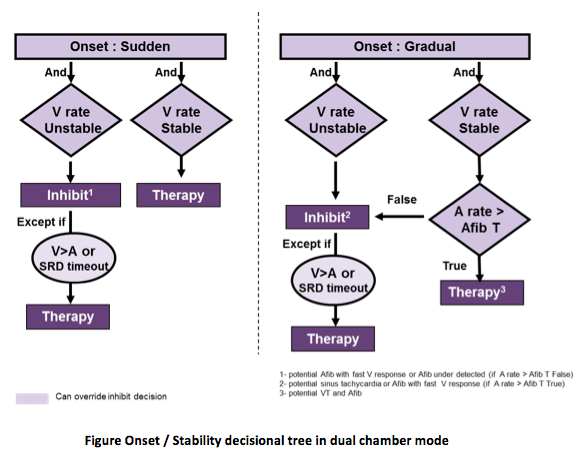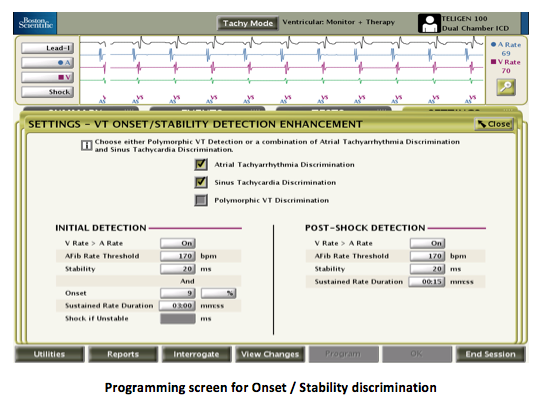Various arrhythmia discrimination algorithms can be programmed with a view to increase the specificity and lower the rate of inappropriate therapies:
- Rhythm ID
- Onset/Stability
- OFF: diagnosis based on the heart rate without additional discrimination.
In the contemporary devices, the discriminators can be programmed in either or both VT zones but not in the VF zone.
1 - DISCRIMINATION PARAMETERS
The presence of an atrial lead enables an uninterrupted comparison of the ventricular rate with the atrial rate. This comparison is the first applicable discriminator in dual and triple chamber defibrillators, though evidently not with a single chamber device.
A certain number of discriminators can be programmed to optimize the arrhythmias diagnosis as a function of the choice between Rhythm ID and Onset/Stability and as a function of the presence of an atrial lead (or of its reliable function):
Ventricular rate > Atrial rate
This setting can be programmed on dual or triple chamber defibrillators by selecting Rhythm ID or Onset/Stability.
The discrimination V rate > A rate (ventricular rate faster than atrial rate) is based on a comparison between the atrial and ventricular rates. When the ventricular rate is faster than the atrial rate, the treatment is triggered regardless of the analysis of the other discriminators. Consequently, the ventricular rate prevails over all other discriminators.
The analysis compares a) the average rate of the last 10 ventricular cycles preceding the end of Duration, with b) the average rate of the last 10 atrial cycles preceding the end of Duration.
- If the average ventricular rate is ≥10 bpm faster than the average atrial rate, it is declared to be faster than the atrial rate (marked as “True” on the Episode Detail Report) and therapy may be initiated.
- If the average ventricular rate is not ≥10 bpm faster than the average atrial rate (marked as “False” on the Episode Detail Report), the treatment may be inhibited if the other discriminators are in favor of an SVT (the analysis of V rate > A rate continues throughout the episode).
V rate > A rate is not evaluated during the redetection following the delivery of ATP.
Vectors correlation
This discriminator is available on the platforms of single, double and triple chamber defibrillators by selecting the Rhythm ID option. It compares, during the initial detection of a tachyarrhythmia, the conduction vector (morphology and EGM synchronization) with a reference EGM recorded during normal sinus rhythm.
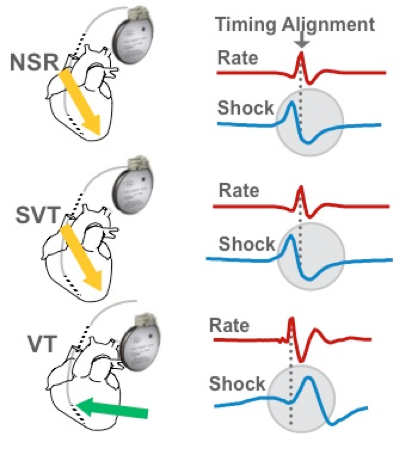
The shock electrogram is used for comparison, the near field being used for the alignment. The comparison between the reference EGM and the EGM during tachycardia is calculated from the amplitudes of eight-time prescribed comparison points (shock channel).

When a rapid rhythm is detected, the device measures the correlation between the waveform of each ventriculogram detected with a recorded reference template and classifies each cycles as correlated or non-correlated.
Correlation of each beat starts only after the third fast beat occurs. The following beats are immediately classified:
- Paced beats classified as Correlated
- Beats in the VF zone automatically are classified as Uncorrelated
- Beats that are too fast <= 260 ms or 230 bpm) for RID to calculate correlation are classified as Uncorrelated
If a beat’s correlation classification is known, it is included in the 10 beats used to classify the rhythm and determine the RhythmMatch value.
STEP ONE
- Classification starts after the third fast beat.
- Each beat is measured, its percent match determined.
- The beat is classified as correlated (match) or uncorrelated (doesn’t match) based on the threshold.
STEP TWO
- The rhythm is classified as RID+ (rhythm is correlated) or RID- (rhythm is uncorrelated) using the last 10 beats.
- The rhythm will be correlated (classified as an SVT) if 3 or more of the last 10 beats meet or exceed the threshold
Programming of the RhythmMatch parameter adjusts the threshold used by the vectors correlation to determine whether the cycle analyzed is correlated with its template in normal sinus rhythm. In the latest devices, this threshold is programmable between 70 and 96%, with a nominal value set at 94%. In older devices, this threshold was not programmable and fixed at 94%.
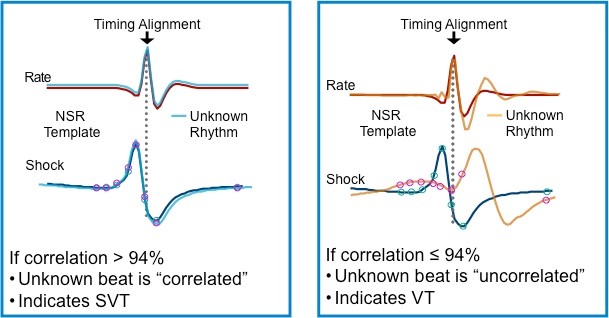
Programming of the RhythmMatch parameter adjusts the threshold used by the vectors correlation to determine whether the cycle analyzed is correlated with its template in normal sinus rhythm. In the latest devices, this threshold is programmable between 70 and 96%, with a nominal value set at 94%. In older devices, this threshold was not programmable and fixed at 94%.
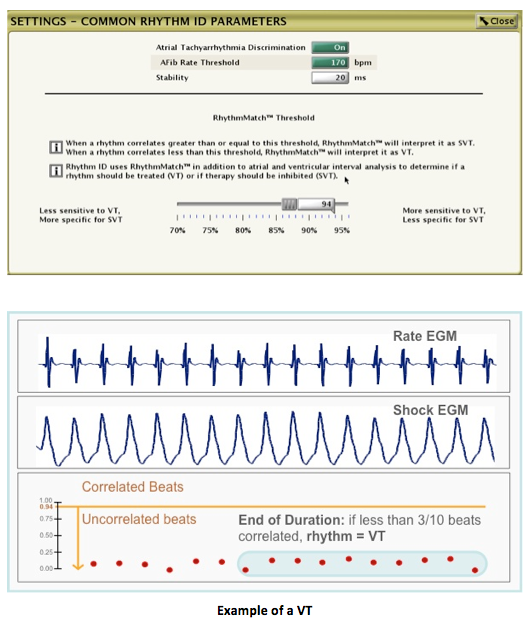
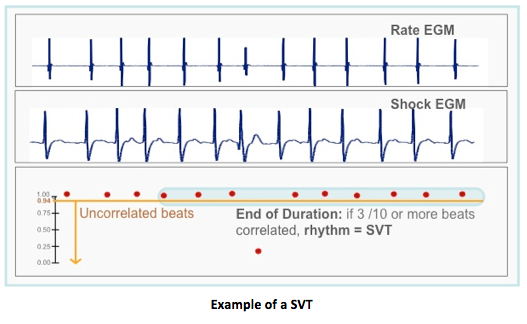
The reference template can be automatically recorded passively or actively. With the passive method, the device looks every 2 h for the presence of a spontaneous ventricular event in order to record the reference template without changing the programmed settings. Conversely, with the active method, a search for spontaneous ventricular events takes place every 28 h during a temporary change of the settings, including a decrease in the pacing rate and prolongation of the AV delay, to promote the emergence of spontaneous ventricular events. The active method is preferred in presence of a high percentage of ventricular paced events (in totally pacemaker-dependent patients, no discrimination must be programmed). A reference template can also be recorded in real time, using the programmer.
Atrial fibrillation rate threshold
This setting can be programmed in dual or triple chamber defibrillators by selecting the Rhythm ID or Onset/Stability option. The atrial fibrillation (AFib) Rate Threshold is analyzed necessarily in association with the Stability setting. If the atrial rate is faster than the AFib Rate Threshold and the ventricular rhythm is classified as unstable, the device diagnoses the ventricular rhythm as conducted from AFib. The atrial analysis begins at the onset of the detected ventricular tachyarrhythmia. Each atrial interval is classified as faster or slower than the AFib Rate Threshold interval. When 6 of the last 10 intervals are faster than the AFib Rate Threshold, the device diagnoses AFib. The ventricular stability is then ascertained and, if unstable, the treatment is withheld. If no therapy is delivered by the device, the atrial rate continues to be monitored and, as long as 4 of 10 intervals remain classified as fast, AFib is considered to be present. The treatment remains inhibited by the AFib Rate Threshold/Stability until one of the following events occurs:
- the atrial rate falls below the AFib Rate Threshold
- the ventricular rhythm stabilizes
- if programmed ON, V Rate > A Rate is True
- Sustained Rate Duration times out
Stability Analysis
This discriminator is available with single, dual and triple chamber defibrillators by selecting the Rhythm ID or Onset/Stability options. It can be applied to:
- discriminate AFib (usually unstable) from VT (usually stable)
- favor electrical shock for unstable rhythm (VF or polymorphous VT) or by ATP for a stable rhythm (stable monomorphic VT)
Stability is analyzed by measuring the variability of the tachycardia cycle length. The differences between ventricular cycles and the average difference are calculated throughout the Duration. When Duration expires, the rhythm stability is evaluated by comparing the current average difference with the programmed Stability and Shock if Unstable thresholds. If the average difference is greater than the programmed thresholds, the rhythm is declared unstable. Independent thresholds are available for the Stability (inhibiting) or Shock If Unstable functions.
Onset
This discriminator is available with single, dual and triple chamber defibrillators by selecting the option Onset/Stability. It is intended to inhibit the treatment of ventricular tachyarrhythmias in the slowest rate zone when the rate increase is gradual. It is limited to the slowest zone of a multizone configuration.
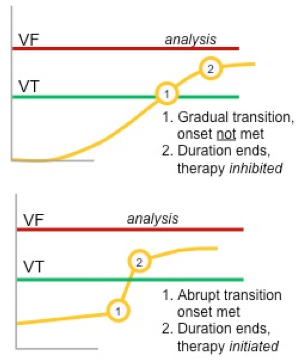
When a detection window is satisfied, the pulse generator starts the calculation of sudden Onset in two consecutive stages.
- Stage 1 measures the ventricular cycles before the onset of the episode and locates the pair of adjacent intervals (pivot point) where the cycle length has shortened the most. If the cycle length shortening is equal to or greater than the programmed Onset value, stage 1 declares the onset to be sudden.
- Stage 2 then compares other intervals; if the difference between the average interval preceding the point pivot and 3 out of the first 4 intervals following the pivot point is equal to or greater than the programmed Onset threshold, stage 2 declares that the onset was sudden.
If both stages declare that the rhythm onset was sudden, treatment can be delivered. If one of the two stages indicates a gradual onset, the initial ventricular therapy is inhibited in the slowest zone. The treatment is not inhibited by Onset if the rate accelerates toward a faster ventricular zone.
This parameter can be programmed as a percentage of the cycle length or as the length of the cycle in ms. The selected Onset value is the smallest difference that must exist between intervals that are below and intervals that are above the lowest programmed rate threshold.
Additional Features:
- V Rate > A Rate
If V is faster than A, indicates ventricular rhythm and initiates therapy
- AFib Rate Threshold
Can be programmed (together with stability) to inhibit ventricular therapy if the atrial rhythm is fast
- Sustained Rate Duration
At end of SRD timer, therapy is provided
Sustained Rate Duration (SRD)
This discriminator is available with single, dual and triple chamber defibrillators by selecting the Rhythm ID or Onset/Stability options. It allows the delivery of programmed ventricular therapy after a programmable duration (based on a clock) even if the other discriminators are in favor of a supraventricular origin of the arrhythmia. SRD can be programmed for the VT and VT-1 zones separately, and an independent post-shock SRD value can be programmed.
2 - COMBINATION OF DIFFERENT DISCRIMINATORS
These different discriminators can be combined with a view to optimize the discrimination of the arrhythmias origin.
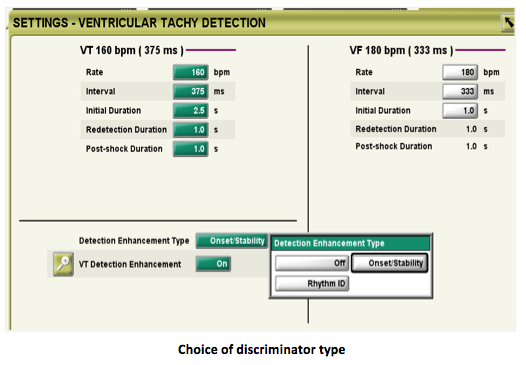
RhythmID
This option enables the combination of several discriminators assuming the presence of a properly functioning atrial lead: AFib Rate Threshold, V rate > A rate, stability and Vectors correlation. These combinations are only available for the initial detection. AFib Rate Threshold and V rate > A rate are both active when atrial tachyarrhythmia Discrimination is activated. If V rate > A rate is programmed ON and is True, it preempts all other discriminators.
When atrial tachyarrhythmia Discrimination is programmed on OFF, the vectors’ correlation is applied for the initial detection and stability for the post-shock detection.
When all these discriminators are active, the device proceeds in different stages:
- if the ventricular rate is considered faster than the atrial rate, VT is diagnosed
- if the ventricular rate is not considered faster than the atrial rate, the analysis of the vectors during the initial detection ascertains whether the correlation between the patient’s rhythm during tachycardia and the reference template is greater than or equal to the programmed RhythmMatch Threshold. If true, the rhythm is classified as SVT and the treatment is inhibited.
- if the correlation between the patient’s rhythm during tachycardia and the reference template is greater than or equal to the programmed RhythmMatch Threshold (in favor of VT or in favor of SVT with aberrancy), the stability and the AFib Rate Threshold are analyzed. If the ventricular rhythm is unstable and the atrial rate is rapid (in favor of AFib conducted with aberrant conduction), the rhythm is diagnosed as SVT and the treatment is inhibited.
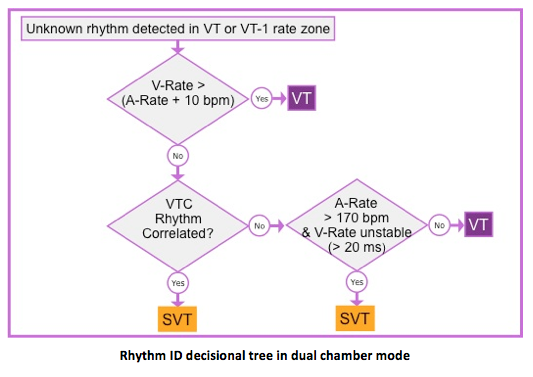
Onset/Stability
This option enables the combination of several discriminators assuming the presence of a properly functioning atrial lead, including AFib Rate Threshold, V rate > A rate, Onset and Stability. These combinations are only available for the initial detection.
AFib Rate Threshold and V rate > A rate are both active when atrial tachyarrhythmia Discrimination is activated. If V rate > A rate is True, it pre-empts all other discriminators.
If AFib Rate Threshold, Stability and Onset are all activated ventricular therapy is triggered as long as the arrhythmia’s onset is sudden and the ventricular rate is stable or the atrial rate is below the AFib Rate Threshold.
With a single chamber defibrillator, when Onset and Stability are programmed, two options are available:
- Onset and Stability: for a therapy to be delivered, both criteria (sudden onset and stable rhythm) are needed.
- Onset or Stability: for a therapy to be delivered, a single positive criterion (sudden onset and/or stable rhythm) suffices.
